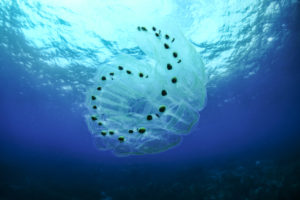Every now and then, divers encounter weird and wonderful creatures such as tunicates. These marine invertebrates are a member of the subphylum Tunicata, which is part of the Chordata phylum, which includes animals with dorsal nerve cords. Some tunicates are solitary; some form colonies. They’re marine filter feeders, with water-filled bodies shaped like sacs. They use their two tubular openings, called siphons, to draw in and expel water. Most adult tunicates are permanently attached to rocks or other hard surfaces, but some, such as salps and pyrosomes swim in the sea’s pelagic zone. We’ll focus on these two here.
Salps

Salps are often circular-shaped, free-floating tunicates. They move either singularly or in groups by contracting their bodies. This in turn thrusts water through their gelatinous bodies and moves them through the ocean. They then filter the water, feeding on phytoplankton. The presence of salps is an accurate way of assessing when plankton blooms occur.
You’ll find salps worldwide, often floating on the surface in a conjoined colony. Divers most often see them in the southern ocean though, where plankton blooms are most common.
The denser a plankton bloom, the shorter lived the salps. When they consume large amounts of plankton, salps can reach great sizes. But when they have depeleted all the plankton stocks in the area, they will quickly die, unable to support themselves.
Pyrosomes
Much like salps, pyrosomes live in warm seas. Divers will find them most commonly in the top layer of the water column, although some may reside in deep water. They form cone-shaped colonies, sometimes thousands strong, known as zooids. When zooids link together, they can be over 33 feet (10 m) long with a bumpy texture.
Each zooid is only a few millimeters in size, and like salps, they draw in water from the outside to their internal filtering mesh. There they extract microscopic plankton and then expel the filtered water to the inside of the cylinder of the colony for propulsion and feeding.
Pyrosomes are fascinating creatures, often falling prey to other marine creatures such as turtles and seabirds. Pyrosomes are brightly bioluminescent, flashing a blue-green, and at times white-hot light in the dark, which is a result of the thousands of individual zooids responding to each other.

